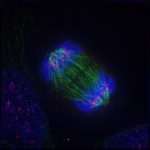Definition
noun
The second stage in meiosis II after prophase II, and highlights the alignment of chromosomes along a single plane in the center of the cell
Supplement
Meiosis is a reproductive cell division since it gives rise to gametes. The resulting cells following meiosis contain half of the number of the chromosomes in the parent cell. That is because the parent cell undergoes two meiotic divisions called first meiotic division (meiosis I) and second meiotic division (meiosis II). Each of them has four major phases. These are prophase, metaphase, anaphase and telophase. Each of these phases is designated as I or II depending where it occurs, i.e. in meiosis I or in meiosis II.
Metaphase II is the second stage in meiosis II. It follows prophase II, which primarily highlights the condensation of the chromosomes and the movement of centrosomes to polar regions of the cell. The cell is in metaphase II when the chromosomes align themselves along the metaphase plate through the facilitation of the spindle fibers. The spindle fibers are now attached to the two kinetochores contained in the centromere of each chromosome. Similar to mitotic metaphase, the two kinetochores are bound to the spindle fibers rom opposite poles and they lie on the equatorial plane, readying for the chromosomal movement towards opposite poles in anaphase II.
See also:
- meiosis I
- metaphase
- metaphase I
- anaphase
- chromosome
- centromere



